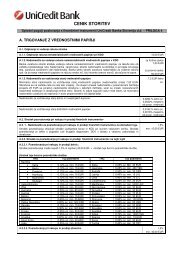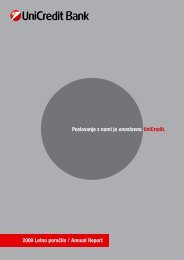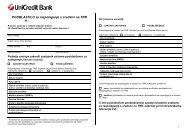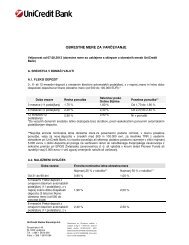Economics Research The UniCredit Weekly Focus
Economics Research The UniCredit Weekly Focus
Economics Research The UniCredit Weekly Focus
Create successful ePaper yourself
Turn your PDF publications into a flip-book with our unique Google optimized e-Paper software.
26 September 2013 <strong>Economics</strong> & FI/FX <strong>Research</strong><strong>Weekly</strong> <strong>Focus</strong>Vulnerability factor #1: high corporate leverageTo get a better understanding of the implications of high corporate indebtedness, we look atthe experience of Japan’s corporate sector after the eruption of the financial crisis in 1990.Just to be clear: we are not suggesting that in the euro area as a whole the corporate sector isfacing problems of the same magnitude as in Japan in the aftermath of the 1990s crisis. As amatter of fact, corporate indebtedness in the euro area is currently well below the 150% peakrecorded in Japan in the mid-1990s. However, a comparison may be helpful for two reasons.First of all, there are some specific euro area countries where the corporate debt position issimilar to that of Japan in the first years of the crisis. In this regard, Portugal stands out as aproblematic country, both for the level of debt and the lack of a downward trend, while Spainconcerns us for the debt level, but not for its trend (pointing south at a decent pace). Second,the experience of Japan gives a good sense of the multi-year implications for investmentwhich can originate from a phase of corporate deleveraging after a credit-fuelled boom.Chart 11 shows that the corporate debt overhang in Japan was followed by a very long periodwhen firms turned into net savers, and significantly so. This allowed the corporate sector tostart reducing its leverage. This process has been running for fifteen years, and a stop orreversal to the net lending position of Japanese NFCs does not seem imminent. In the meantime,Japan’s “new normal” has become one where private non-residential investment as a share ofGDP has fluctuated in a narrow range, significantly below the levels prevailing before thefinancial crisis (see chart 12).Overall, some broad similarities with the Japanese experience suggest caution when assessingthe upside potential for capex in the eurozone. We suspect that the upcoming capexrecovery will be less strong and more subject to downside risks compared to pre-crisis cycles.CHART 11: JAPANESE FIRMS STILL IN SAVING MODECHART 12: JAPAN’S “NEW NORMAL” AMID DELEVERAGING10.08.06.04.02.00.0-2.0-4.0-6.0-8.0-10.0-12.0-14.0NFCs: Financing gap (% GDP) - LSNFCs: Debt/GDP (%) - RS901980 1984 1988 1992 1996 2000 2004 2008 2012160150140130120110100Private non-residential investment (% of GDP)212019181716151413121980 1984 1988 1992 1996 2000 2004 2008 2012Source: BIS, Cabinet Office, Thomson Datastream, <strong>UniCredit</strong> <strong>Research</strong>Vulnerability factor #2: tight lending standards<strong>The</strong> cost of market financing for eurozone firms has dropped considerably in the last year,thanks to the strong performance of equity and corporate bond markets after the OMTannouncement. However, only a limited number of euro area companies have benefited fromthis improvement. Given that most firms, particularly in the periphery, do not have access tomarket financing and rely chiefly on bank lending, supply-side credit constraints are anotherkey headwind to consider when assessing the strength and sustainability of a capex recovery.<strong>The</strong> main risk to evaluate is whether banks may not be ready/willing to increase loan supplywhen credit demand enters a moderate recovery phase. While this is certainly a possibility,we have reasons to believe that the recent signs of broader economic recovery will progressivelycontribute to alleviate some of these concerns.<strong>UniCredit</strong> <strong>Research</strong> page 9 See last pages for disclaimer.
















